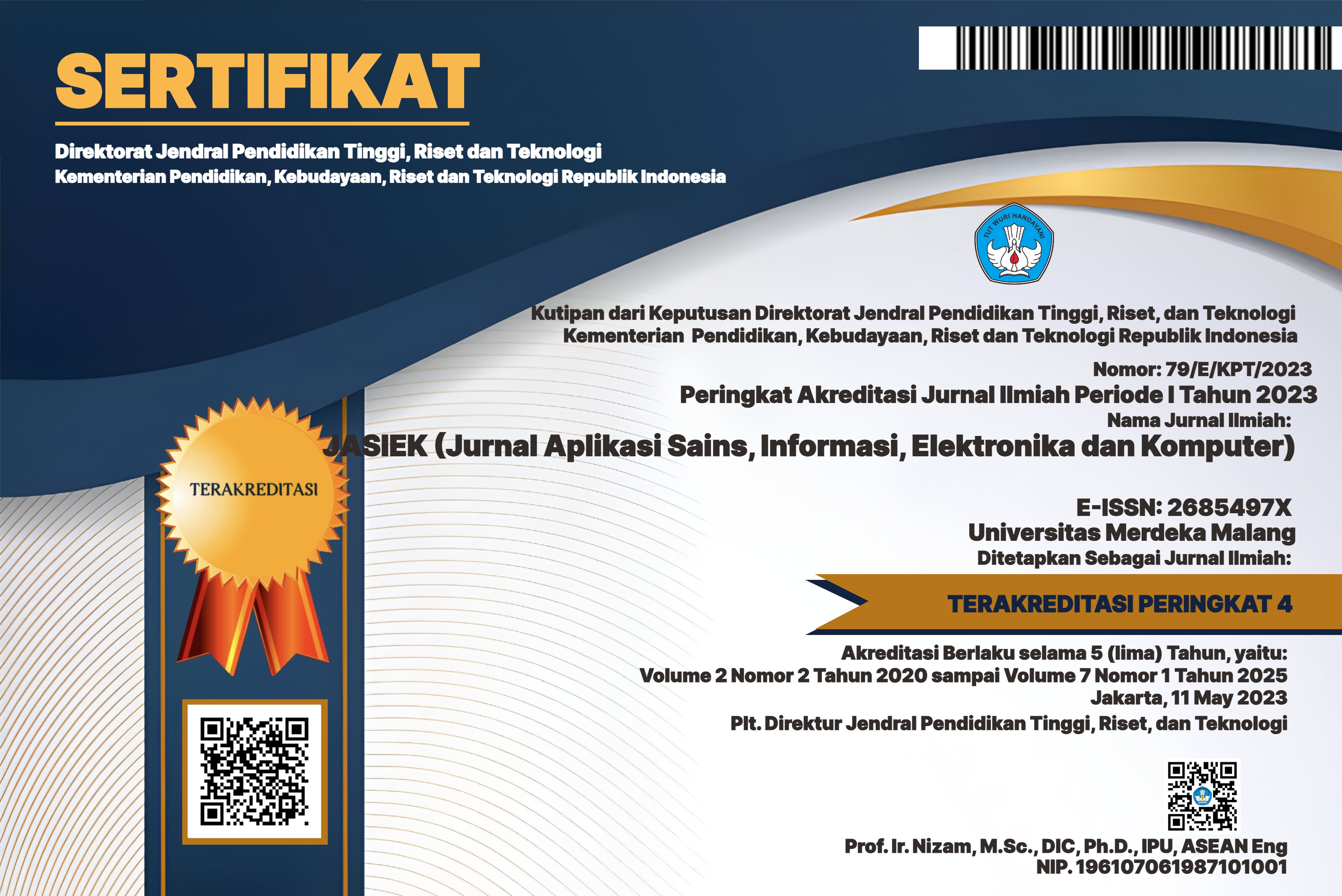Analisis Pengaruh Respon Kontrol Posisi Motor dan Beban terhadap Nilai Arus serta Tegangan pada Kontroler Motor BLDC
DOI:
https://doi.org/10.26905/jasiek.v2i2.5361Keywords:
Odrive, Motor BLDC, Sistem pengaman, Overcurrent, OvervoltageAbstract
The use of BLDC motors is currently on the rise, especially in Indonesia. The advantages are the high efficiency of the asynchronous motor, the small size of the electronics, the sensor and the control system. One obstacle to the use of BLDC motors is that the BLDC motor control system is still underdeveloped. The controller becomes the main system for starting the BLDC motor. In addition, the controller requires a security system to prevent damage. The purpose of this study is to analyze and study the current and voltage safety system on the controller to minimize damage. The data collection method in this study was to sample the highest current and voltage values in each position control on the Odrive controller and load changes on the prototype electric vehicle. The results of a study with a Dys2826 1400 kV DC induction motor showed no significant effect of position control variations on current and voltage at a distance of 1 to 5 meters. In this case, a change in load affects the values of current and voltage at a load of 1 to 5 kilograms. This is because the motor needs a lot of current to maintain position in position control mode.Downloads
References
N. Masudi, “Desain Controller Motor Bldc Untuk Meningkatkan Performa ( Daya Output ) Sepeda Motor Listrik,†pp. 1–65, 2014.
I. V. RobbyValentino, N. Nachrowie, D. W, and Mujahidin, “Rancang Bangun Sistem Penilaian Kesegaran Jasmani A Di Jajaran TNI-AD Berbasis RFID,†JASIEK (Jurnal Apl. Sains, Informasi, Elektron. dan Komputer), vol. 2, no. 1, pp. 98–106, 2020.
V. H. Kumar, “Over current and over voltage protection of permanent magnet brushless dc motor using wavelet analysis,†IOSR J. Electr. Electron. Eng., vol. 9, no. 5, pp. 79–86, 2014, doi: 10.9790/1676-09537986.
T. A. S, A. Rabi’, D. Minggu, and I. Mujahidin, “Frequency Hopping Video Real Time Untuk Pengamanan Data Pengintaian Operasi Inteligence TNI,†JASIEK (Jurnal Apl. Sains, Informasi, Elektron. dan Komputer), 2019, doi: 10.26905/jasiek.v1i1.3146.
D. F. C. Kusuma, D. A. Prasetya, F. Kholid, and I. Mujahidin, “Evaluasi Database Senjata Untuk Sistem Keamanan Menggunakan Fuzzy Logic,†JASIEK (Jurnal Apl. Sains, Informasi, Elektron. dan Komputer), 2019, doi: 10.26905/jasiek.v1i2.3524.
M. Wibowo, A. Rabi’, S. Suprayogi, and I. Mujahidin, “Rancang Bangun Sistem Pengamanan Rak Senjata M16 Menggunakan RFID Dan Fingerprint,†JASIEK (Jurnal Apl. Sains, Informasi, Elektron. dan Komputer), 2019, doi: 10.26905/jasiek.v1i2.3525.
A. E. Pambudi, L. Maajid, J. Rohman, and I. Mujahidin, “Aplikasi Penggunaan Joystick Sebagai Pengendalian Remote Control Weapon Station (RCWS) Senjata Mesin Ringan (SMR),†JASIEK (Jurnal Apl. Sains, Informasi, Elektron. dan Komputer), 2019, doi: 10.26905/jasiek.v1i2.3515.
E. Endrayana, D. H. . Wahyuni, N. Nachrowie, and I. Mujahidin, “Variasi Ground Plane Antena Collinear Pada Pemancar Telivisi Analog Dengan Frekuensi UHF 442 MHz,†JASIEK (Jurnal Apl. Sains, Informasi, Elektron. dan Komputer), 2019, doi: 10.26905/jasiek.v1i2.3526.
D. A. Prasetya and I. Mujahidin, “2.4 GHz Double Loop Antenna with Hybrid Branch-Line 90-Degree Coupler for Widespread Wireless Sensor,†in 2020 10th Electrical Power, Electronics, Communications, Controls and Informatics Seminar (EECCIS), Aug. 2020, pp. 298–302, doi: 10.1109/EECCIS49483.2020.9263477.
J. Lasmono, A. P. Sari, E. Kuncoro, and I. Mujahidin, “Optimasi Kerja Peluncur Roket Pada Robot Roda Rantai Untuk Menentukan Ketepatan Sudut Tembak,†JASIEK (Jurnal Apl. Sains, Informasi, Elektron. dan Komputer), 2019, doi: 10.26905/jasiek.v1i1.3149.
M. T. Prakarsa, D. Wahyuni, N. Rachman, and I. Mujahidin, “Optimasi Sistem Komunikasi Dari Ht Dengan Hp Dalam Pelaksanaan Tugas Operasi TNI AD Menggunakan Metode DTMF,†JASIEK (Jurnal Apl. Sains, Informasi, Elektron. dan Komputer), 2019, doi: 10.26905/jasiek.v1i1.3150.
Downloads
Published
Issue
Section
License
Authors who publish with this journal agree to the following terms:
The journal allow the authors to hold the copyright without restrictions and allow the authors to retain publishing rights without restrictions.
Authors retain copyright and grant the journal right of first publication with the work simultaneously licensed under a Creative Commons Attribution-ShareAlike 4.0 International License that allows others to share the work with an acknowledgement of the work's authorship and initial publication in this journal.
Authors are able to enter into separate, additional contractual arrangements for the non-exclusive distribution of the journal's published version of the work (e.g., post it to an institutional repository or publish it in a book), with an acknowledgement of its initial publication in this journal.
Authors are permitted and encouraged to post their work online (e.g., in institutional repositories or on their website) prior to and during the submission process, as it can lead to productive exchanges, as well as earlier and greater citation of published work (See The Effect of Open Access).

This work is licensed under a Creative Commons Attribution-ShareAlike 4.0 International License.










